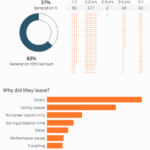The turnover rate is a metric used to quantify personnel turnover relative to the workforce, helping to assess its cost impact on the company and providing a foundation for addressing the underlying causes of turnover (see turnover analysis). It is calculated using the following formula:
Turnover Rate = (Number of Staff Departures ÷ Average Workforce) × 100
However, there is ongoing debate about which value should be used in the denominator of this formula, as staff departures are recorded over a period, while workforce size is a snapshot at a specific point in time. Some alternative approaches to the denominator include:
-
“Headcount at the beginning of the period + new employees during the period”
-
“Average number of employees = Headcount at the beginning of the period – number of departures + new employees”
Despite these differences, the key to obtaining meaningful data from turnover rates is using a consistent denominator and ensuring the “numerator” differentiates between various types of employee departures. These could include reasons for leaving, job functions, employee groups, and hierarchical levels. Ideally, turnover should be broken down into various rates for more accurate analysis.
Ultimately, it is essential to calculate several, clearly defined turnover rates to accurately monitor and address workforce dynamics.
« Back to Glossary Index





![15 Employee Offboarding Templates That Save Hours of HR Time [Free Downloads] 15 Employee Offboarding Templates That Save Hours of HR Time [Free Downloads]](https://i1.wp.com/www.hrcloud.com/hubfs/Header.png?w=150&resize=150,100&ssl=1)
